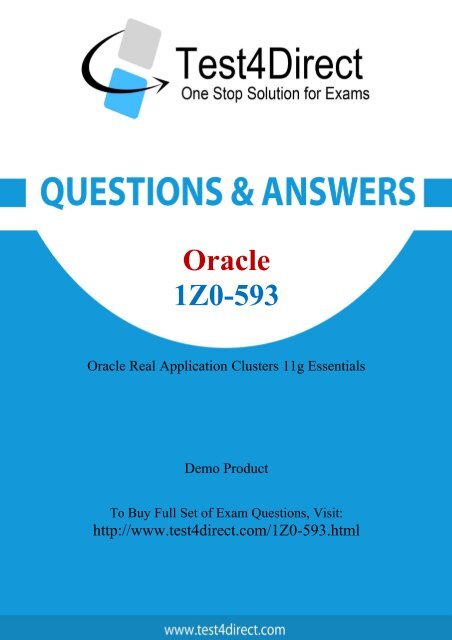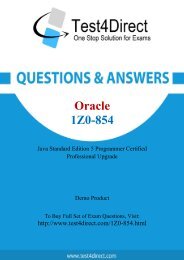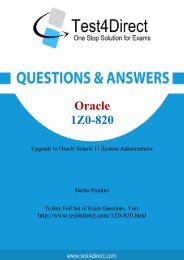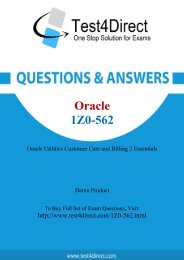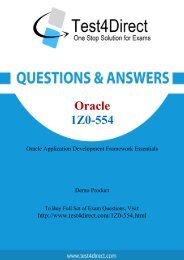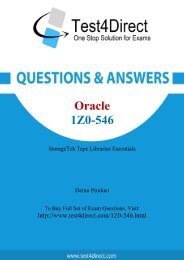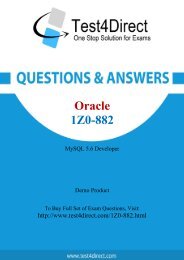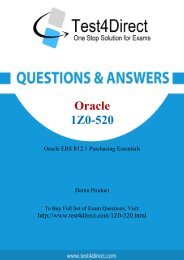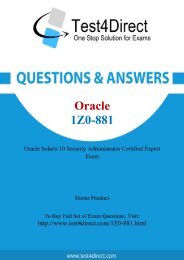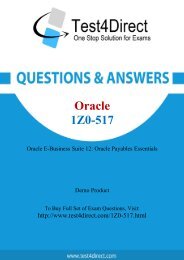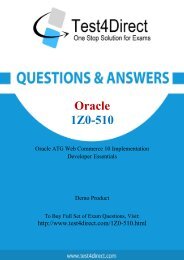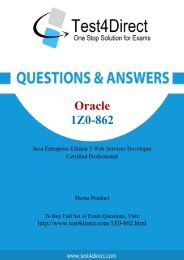1Z0-593 BrainDumps Discount
Test4Direct provides latest PDF questions of Oracle 1Z0-593 exam. You have an opportunity to pass the Oracle 1Z0-593 exam in one go. Test4Direct is most accurate source to prepare Oracle 1Z0-593 exam as your success will become site’s responsibility after purchasing 1Z0-593 exam product. There are also lots of discounts and promotion offers that you can avail. Let’s try a free demo http://www.test4direct.com/1Z0-593.html
Test4Direct provides latest PDF questions of Oracle 1Z0-593 exam. You have an opportunity to pass the Oracle 1Z0-593 exam in one go. Test4Direct is most accurate source to prepare Oracle 1Z0-593 exam as your success will become site’s responsibility after purchasing 1Z0-593 exam product. There are also lots of discounts and promotion offers that you can avail. Let’s try a free demo http://www.test4direct.com/1Z0-593.html
Create successful ePaper yourself
Turn your PDF publications into a flip-book with our unique Google optimized e-Paper software.
Oracle<br />
<strong>1Z0</strong>-<strong>593</strong><br />
Oracle Real Application Clusters 11g Essentials<br />
Demo Product<br />
To Buy Full Set of Exam Questions, Visit:<br />
http://www.test4direct.com/<strong>1Z0</strong>-<strong>593</strong>.html
Question: 1<br />
Once OUI recognizes a set of nodes in a cluster, which three choices does it offer when installing the<br />
Oracle Database 11g Release 2 software?<br />
A. You can only install the Oracle Database with the RAC option on selected nodes.<br />
B. OUI forces you to configure ASM for shared storage before proceeding.<br />
C. You can install the Oracle Database as a single instance or with the RAC option on all the nodes.<br />
D. You can install the Oracle Database as a single instance or with the RAC option on selected nodes.<br />
E. You can install Oracle RAC One Node.<br />
Question: 2<br />
Answer: BD E<br />
Explanation:<br />
B, D: Complete the prerequisite tasks for converting to an Oracle RAC database:<br />
Oracle Clusterware and Oracle Database software is installed on all target nodes.<br />
Oracle Clusterware is started.<br />
(D) The Oracle Database binary is enabled for Oracle RAC on all target nodes.<br />
(B) Shared storage is configured and accessible from all nodes.<br />
User equivalency is configured for the operating system user performing the conversion.<br />
Enterprise Manager agents are configured and running on all nodes, and are configured with the<br />
cluster and host information.<br />
The database being converted has been backed up successfully.<br />
E: Installing Oracle RAC One Node is available starting with Oracle Database 11g Release 2 (11.2.0.2).<br />
Note:<br />
* By default, the standard Oracle Database 11g software installation process installs the Oracle RAC<br />
option when OUI recognizes that you are performing the installation on a cluster.<br />
In the following line, which is the result of a “crsctl query css votedisk” command (which is missing<br />
the column headers in the output) – what does the [DATA] indicate?<br />
1. ONLINE 62a46a99b0434f8abf16f338c85203160 (/dev/xvdc1) [DATA]<br />
A. It Indicates that the Voting Disk contains Oracle Cluster ware data<br />
B. It Indicates that the Voting Disk is managed in the ASM diskgroup "DATA"<br />
C. It Indicates that the Voting Disk "DATA" is online on disk /dev/xvdc1<br />
D. It indicates that the ASM diskgroup "DATA" stores only the Voting Disk<br />
Answer: B<br />
Explanation:<br />
See example below.<br />
Note:<br />
* Use the crsctl query css votedisk command to display the voting disks used by Cluster<br />
Synchronization Services, the status of the voting disks, and the location of the disks, whether they
are stored on Oracle ASM or elsewhere.<br />
* Example:<br />
The crsctl query css votedisk command returns output similar to the following:<br />
$ crsctl query css votedisk<br />
## STATE File Universal Id File Name Disk group<br />
-- ----- ----------------- --------- ---------<br />
1. ONLINE 296641fd201f4f3fbf3452156d3b5881 (/ocfs2/host09_vd3) []<br />
2. ONLINE 8c4a552bdd9a4fd9bf93e444223146f2 (/netapp/ocrvf/newvd) []<br />
3. ONLINE 8afeee6ae3ed4fe6bfbb556996ca4da5 (/ocfs2/host09_vd1) []<br />
Located 3 voting disk(s).<br />
Reference: Oracle Clusterware Administration and Deployment Guide , CRSCTL Utility Reference<br />
Question: 3<br />
Which three items can be stored on the ACFS (Oracle ASM Cluster File System)?<br />
A. Oracle Database Homes (shared home approach)<br />
B. Any type of application-related configuration or log files<br />
C. The Oracle Grid Infrastructure Home<br />
D. Oracle Backup Sets (RMAN backup sets)<br />
Question: 4<br />
Question: 5<br />
Answer: A, B, D<br />
Explanation:<br />
Oracle ASM Cluster File System (ACFS) is a general purpose cluster file system implemented as part<br />
of ASM. It can be used to store almost anything, including the database executables. The only things<br />
that should not be stored in ACFS are the Grid Infrastructure home and any Oracle files that can be<br />
directly stored in Oracle ASM.<br />
Reference: Oracle ASM Cluster File Systems (ACFS) in Oracle Database 11g Release 2<br />
When installing the Oracle Database with OUI, when are configuration scripts executed?<br />
A. Before installation begins<br />
B. After prerequisites check finished<br />
C. After the software has been installed<br />
D. Automatically throughout the installation process<br />
Answer: C<br />
Explanation:<br />
If prompted, execute the root.sh script as the root user to complete the installation, and click OK.<br />
Note:<br />
* Oracle Universal Installer (OUI)<br />
Reference: Oracle Database Client Installation Guide<br />
You want to stop a CRSCTL command that is active. How should you do this?
A. With the abort command<br />
B. With CTRL-C<br />
C. With CTRL-X<br />
D. With CTRL-A<br />
E. With CTRL-ALT-DEL<br />
Question: 6<br />
Question: 7<br />
Answer: B<br />
Explanation:<br />
Stopping Active SRVCTL Commands<br />
Although you may be able to cancel running SRVCTL commands by pressing the Control-C keys, you<br />
may corrupt your configuration data by doing this.<br />
You are strongly advised not to attempt to terminate SRVCTL in this manner.<br />
You want to install Grid Infrastructure for a cluster and the Oracle Database software (with the RAC<br />
option). Do you need SSH user equivalency?<br />
A. Yes, to ensure security during the installation.<br />
B. Yes, to set up administrative privileges for the DBA.<br />
C. Yes, to allow the use of SSH and SCP without being prompted for a pass phrase.<br />
D. No, you don't need SSH user equivalency.<br />
Answer: C<br />
Explanation:<br />
During the installation of Oracle RAC, OUI needs to copy files to and execute programs on the other<br />
nodes in the cluster. In order to allow OUI to do that, you must configure SSH to allow user<br />
equivalence. Establishing user equivalence with SSH provides a secure means of copying files and<br />
executing programs on other nodes in the cluster without requiring password prompts.<br />
Which two statements about the SRVCTL utility are correct?<br />
A. SRVCTL must be run from the RAC database ORACLE_HOME/bin directory when used to manage<br />
that dababase.<br />
B. The SRVCTL command cannot be used to manage Oracle Grid Infrastructure.<br />
C. Every command requires an object on which to operate.<br />
D. A comma-delimited list should be enclosed in single quotes.<br />
Answer: A, C<br />
Explanation:<br />
A: Always use SRVCTL from the Oracle_home of the database that you are administering.<br />
C: SRVCTL expects the following command syntax:<br />
srvctl command object options<br />
Incorrect:
Not B: Guidelines for Using SRVCTL in Oracle Real Application Clusters<br />
Not D: On the Windows platform, when specifying a comma-delimited list, you must enclose the list<br />
within double-quotes ("...,...").<br />
Question: 8<br />
How do you enable automatic backup of the OCR?<br />
A. With the ocrconfig autobackup command<br />
B. With the ocrconfig -backup command<br />
C. With the ocrconfig -backuploc command<br />
D. You don't have to enable this, Oracle Clusterware does it automatically<br />
Explanation:<br />
Automatic backup of OCR is done by CRSD process and every 3 hours.<br />
Answer: D
THANKS FOR TRYING THE DEMO OF OUR PRODUCT<br />
Visit Our Site to Purchase the Full Set of Actual <strong>1Z0</strong>-<strong>593</strong> Exam Questions With Answers.<br />
http://www.test4direct.com/<strong>1Z0</strong>-<strong>593</strong>.html<br />
We Also Provide Practice Exam Software That Simulates Real Exam Environment And Has<br />
Many Self-Assessment Features. Download Free Product Demo From:<br />
http://www.test4direct.com/<strong>1Z0</strong>-<strong>593</strong>.html<br />
Money Back Guarantee<br />
Check Out Our Customer Testimonials


